- GreenMatch
- Blog
- Eco-Design Energy-Efficient Homes
Eco-Friendly House Design: A Detailed Overview

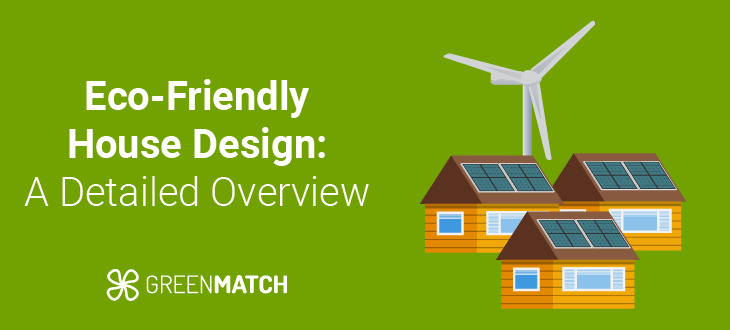
- Eco-friendly house design uses sustainable materials, insulation, ventilation and design concepts such as biophilic design to have as little environmental impact as possible.
- The Passivhaus standard can reduce a home’s energy consumption by 90%, many eco-homes aim to incorporate this standard in their design.
- Homes in the UK contribute to around 20% of emissions, making eco-home design an essential part of creating a more sustainable future.
- The UK has incentives such as the Boiler Upgrade Scheme and ECO4, which encourage homeowners to adopt eco-friendly designs, making sustainable homes more accessible.
- The future of sustainable housing will be shaped by smart technology, nature-integrated design, and a growing push to make eco-homes more affordable.
Eco-friendly house design is no longer a futuristic concept suited for the most innovative architects, engineers and builders. It is now a practical and responsible response to the growing environmental concerns we face today.
Through careful planning and research, eco-friendly houses utilise innovative technologies such as high-quality HVAC systems, insulation and renewable energy resources to help reduce carbon emissions caused by traditional construction of homes.
However, eco-friendly house design is not just for homeowners looking to create a new home; it can also help homeowners improve their traditional homes with up-to-date and streamlined sustainable designs to reduce energy consumption and lower electricity bills. Below, we dive into why eco-homes are important in today's climate and the fundamental aspects that go into sustainable design.
Why eco-homes are essential
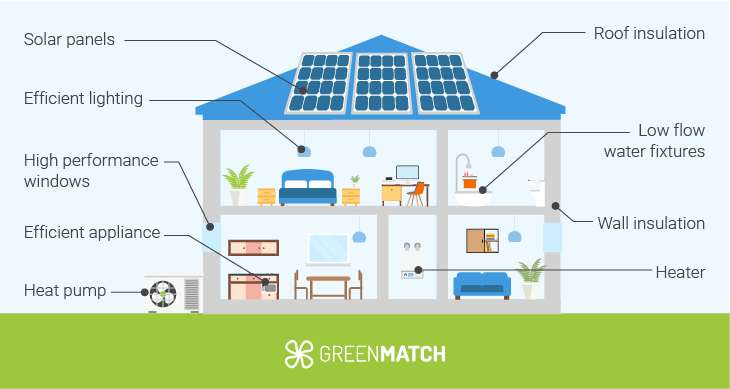
An eco-home aims to have the lowest possible impact on the environment by using sustainable materials, improving insulation, positioning the home to gain natural heat and ventilation and using renewable energy sources.
Eco-homes prioritise a “fabric first” approach, which focuses on improving the home’s thermal envelope to lower energy consumption, this is addressed before any other elements are considered, such as renewable energy sources. Additionally, many eco-homes also incorporate biophilic design principles, blending architecture and interiors with elements of nature to support well-being and sustainability.
Biophilic design is an architectural and interior design approach that aims to connect people with nature by incorporating natural elements like light, plants, water, and organic materials into built environments. It aims to enhance well-being, reduce stress, and improve overall health by mimicking natural settings.
Construction is responsible for 37% of total global emissions, according to theWorld Economic Forum. In the UK, domestic homes contribute around 20% of the country’s greenhouse gas emissions each year, according to the National Housing Federation.
As more countries commit to reducing carbon emissions and reaching net-zero goals by 2050, traditional construction has been increasingly recognised as part of the problem. Now more than ever, there is a push for eco-homes. In response, the UK government has introduced the “Heat and Buildings Strategy,” which promotes greener construction through improved insulation and the use of renewable energy sources.
In addition to lowering carbon emissions, eco-friendly homes help both new and existing homeowners reduce their energy consumption, cutting energy bills at a time when costs are rising sharply across the UK.
Design considerations for a sustainable house in the UK
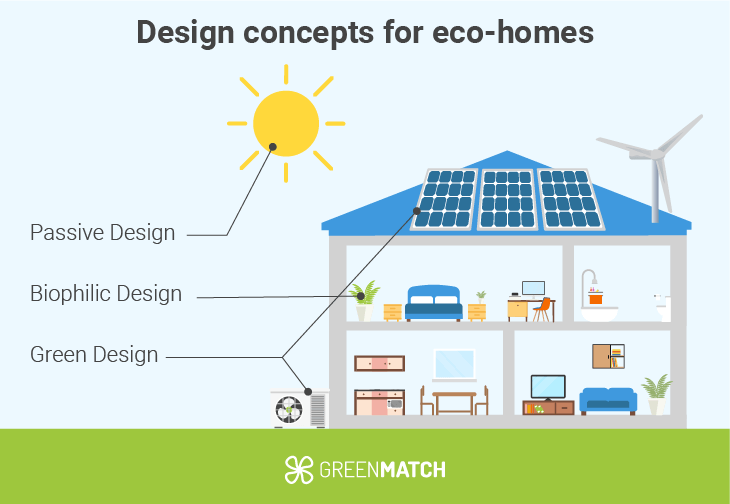
Designing a sustainable house in the UK is no easy feat. It takes a considerable amount of planning and research to maximise a home’s lifespan and ensure it functions effectively while simultaneously promoting sustainability and the health and well-being of its residents.
Every facet of building a home, from the materials used to insulation, ventilation and use of renewable energy sources, needs to be carefully considered. Many eco-homes use a mixture of passive, biophilic and green design techniques to maximise their sustainability.
- Passive design: This design approach uses the surrounding environment to minimise the need for heating or cooling. This involves placing the home in such a way as to maximise natural sunlight and ensure natural ventilation.
- Biophilic design: This design approach incorporates natural elements such as plants and trees within the home. This not only improves air quality but has been shown to reduce stress and enhance the mental health of homeowners.
- Green design: This approach focuses on using sustainable building materials and making the home as energy-efficient as possible. This can include the use of natural or organic materials and the integration of renewable energy sources.
By applying these principles, architects and designers can create homes that are as sustainable as possible. Below, we take a closer look at each of these design considerations in more detail.
Yes, you can make your home more eco-friendly by improving insulation, upgrading to energy-efficient windows and doors, and installing renewable energy sources such as solar panels and biomass boilers.
Energy efficiency and carbon reduction
The key focus for eco-home design is about improving energy efficiency so that homeowners are not as reliant on heating and cooling systems. This not only contributes to the reduction of energy costs but plays a vital role in reducing carbon emissions.
From construction to usage, sustainable home construction aims to produce as little carbon emissions as possible. One of the leading frameworks for this is the Passivhaus standard. The main goal of Passivhaus is to reduce a building's energy consumption by up to 90%, according to the Passive House Institute, while still providing excellent comfort, air quality and durability.
According to the Passivhaus Trust, in order to obtain the Passivhaus standard in the UK, homes need to align with the following principles:
- Focuses on high levels of insulation.
- High performing windows and window frames.
- Airtight building fabric.
- Ensuring the limitation and reduction of weak spots within construction so that heat doesn’t leak out.
- Mechanical ventilation systems are used to extract stale air in the home and pull in fresh air from outside.
In addition to this, eco-homes incorporate renewable energy sources to further boost energy efficiency and reduce carbon emissions. This includes:
- Solar panels for electricity generation.
- Solar thermal systems for generating hot water.
- Air-source or ground-source heat pumps for heating and cooling.
When combined, these design considerations can drastically reduce a home’s environmental footprint while lowering energy bills.
Site planning and building orientation
The position of a house plays a vital role in providing better energy efficiency, water management and biodiversity enhancement. For new-build eco-homes, many architects and designers adopt a passive design approach, allowing the home to gently integrate with and utilise the surrounding environment to its advantage without causing environmental harm.
By positioning a home correctly, such as placing more windows on the south-facing side, it can naturally absorb more heat during the winter months, this is particularly beneficial in the UK’s cooler climate. According to Aiman Albatayneh, the correct orientation of a building is a low-cost option to improve a home’s thermal comfort and helps to decrease cooling and heating energy.
An appropriate building orientation will allow the desirable winter sun to enter the building and allow ventilation in summer by facing the summer wind stream- Aiman Albatayneh
On top of home orientation, eco-homes carefully consider potential building sites. The aim of sustainable homes is to have as little environmental impact as possible, and this also includes construction. Poor planning can lead to habitat destruction, deforestation, and soil erosion, all while contributing to carbon emissions.
According to the UK Green Building Council (UK GBC), several key design approaches can help reduce environmental damage during construction:
- Limiting the extraction of materials to protect eco-systems.
- Optimise design to limit the amount of materials needed during construction.
- Prioritising the use of recycled and bio-materials.
Additionally, enhancing biodiversity around the home is an essential part of sustainable site planning. In the RIBA Sustainable Outcomes Guide, sites should be left in better condition after development than before. This can be achieved by:
- Retaining natural features like trees, hedgerows, and watercourses.
- Creating diverse green spaces such as green roofs, vertical gardens, and pocket parks.
- Establishing habitats that encourage local wildlife, including pollinators and native species.
Sustainable materials
Sustainable materials play a vital role in sustainable house design. Traditional materials such as concrete generate substantial carbon emissions during production. According to the Guardian, concrete generates up to 8% of global CO2 emissions.
As a result, eco-home design heavily focuses on the use of renewable, recyclable, and responsibly sourced materials to help minimise waste and lower the overall carbon footprint of a home. These materials can include:
- Reclaimed and recycled materials: Using reclaimed wood and bricks throughout the home helps avoid landfill waste, reducing carbon emissions.
- Natural insulation: Sheep wool, hemp, and cellulose provide good thermal insulation while being sustainable in its production and degradation.
- Bamboo: This grass is fast-growing and strong, making it an excellent option for flooring and structural elements, which helps combat deforestation.
- Lime plaster: Breathable and naturally antimicrobial, lime plaster regulates indoor humidity and prevents mould growth.
- Hempcrete: A mix of hemp fibres, lime, and water that provides insulation and regulates humidity.
- Recycled concrete: Using crushed concrete from demolished buildings reduces the need for new raw materials.
As the world seeks to reduce waste and embrace environmental responsibility, the growing use of sustainable materials reflects the impact of thoughtful and conscious design choices.
Enhanced indoor air quality
While one of the main concerns of eco-homes is ensuring they have as little environmental impact as possible, another focus is to protect and improve the overall health and well-being of their occupants.
According to the World Health Organization, poor air quality can contribute to health issues such as respiratory issues, heart disease, lung cancer and pneumonia. As a result, sustainable homes focus on enhancing ventilation.
Ventilation allows for natural airflow in a home, removes pollutants, odours and excess water to improve air quality and helps reduce the risk of condensation. A sustainable home should strike a harmonious balance between airtightness to secure thermal efficacy and sufficient ventilation to provide fresh air and prevent dampness.
In eco-home designs, sustainable ventilation can be approached in two ways:
- Natural ventilation: Through windows, doors and vents, air is allowed to circulate within a home. Natural ventilation is improved through proper planning by placing windows and doors on either side of the home to allow wind-driven ventilation and vents on the roof to allow hot air to escape.
- Mechanical ventilation: This operates through mechanical equipment such as fans, blowers and ducts to ventilate a home. While this type of ventilation can incur higher electricity costs, mechanical ventilation with heat recovery is a leading sustainable choice. MVHR extracts state air, adding fresh air into the home while recovering 95% of the heat from outgoing air.
Key elements of eco-house design
Eco-friendly house design is more than just reducing energy consumption. It is also a conscious effort to use more sustainable materials and systems to help minimise environmental impact. Through these conscious efforts, eco-homes become inherently more environmentally responsible and sustainable throughout their entire lifespan, from their construction to their operations. Below are the key elements that define successful eco-house design:
1. Insulation
A well-insulated home is the first step in creating an eco-friendly house. By keeping a home warm in the winter and cool in the summer, effective insulation will help reduce energy bills and lower a home’s carbon emissions. According to the Resolution Foundation, a poorly insulated house burns 58% more gas.
For an eco-friendly house in the UK, it is essential that proper insulation is placed in the key locations where heat loss is most likely to occur, such as the roof, walls and floors.
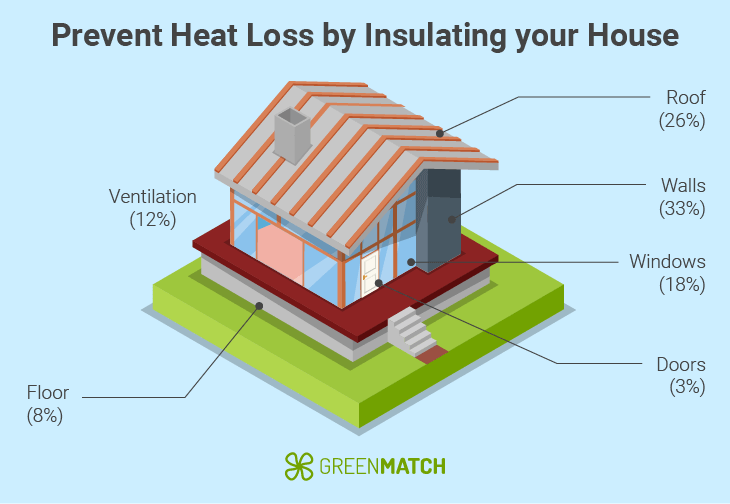
Adding insulation to all areas of a house is just one step in a sustainable design approach. Another key design consideration is choosing the right insulation material. While many materials improve thermal efficiency and reduce carbon emissions, their production processes may have a negative environmental impact.
For example, spray foam is considered one of the best insulation materials available. However, its mixture of toxic chemicals can contribute to environmental harm. Opting for sustainable materials such as sheep wool, cellulose, or hemp can increase the eco-friendliness of a home. Yet, for eco-friendly houses, it is important to balance thermal efficiency with sustainable materials.
Some eco-friendly materials have lower thermal performance. However, proper sustainable design can use tactics such as layering insulation materials to ensure that neither eco-friendliness nor thermal efficiency is compromised.
2. Water management and efficiency
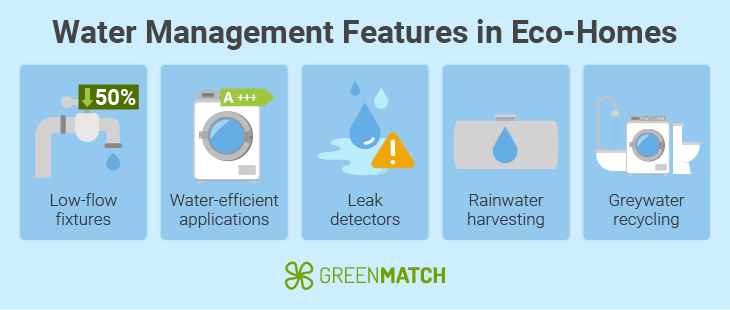
While 70% of the world is covered in water, only 3% of it is freshwater, with only a shocking 1% being accessible to humans, according to the WWF. This makes water efficiency and conservation in eco-homes paramount. Eco-friendly homes use several tactics to minimise water waste:
- Low-flow fixtures: Sustainable homes use low-flow plumbing fixtures, which reduces the amount of water wasted per flush. This can reduce water waste by up to 50%, helping to lower energy costs while conserving water.
- Water-efficient applications: Dishwashers and washing machines with high energy and water efficiency ratings (A+++) consume less water and energy per cycle.
- Leak detectors: These small devices use specialised technology to detect any leaks occurring throughout a home. While this helps avoid any major repair costs, it also acts as a way to reduce water waste.
- Rainwater harvesting: Eco-homes collect rainwater from the roof and store it in tanks to be used for irrigation, toilet flushing and washing, reducing the demand for mains water.
- Greywater recycling: Water from sinks, showers, and washing machines can be filtered and reused for non-drinking purposes like toilet flushing and garden watering.
These conscientious design choices resonate with sustainable living principles and empower homeowners to actively conserve one of the planet's most precious resources.
3. Renewable energy sources
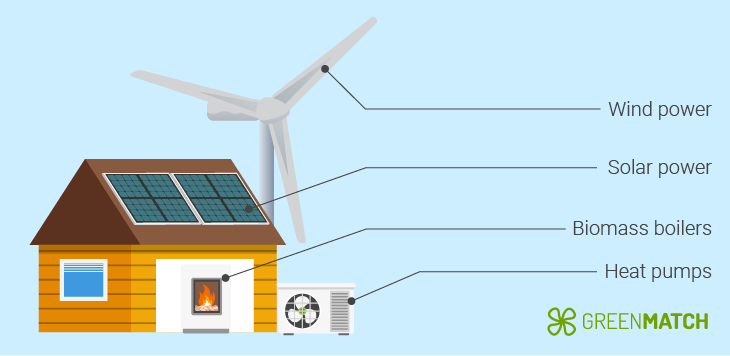
Renewable energy sources for eco-friendly houses reduce the reliance on fossil fuels and help lower costly electricity bills. In the UK, there are several government-backed incentives to encourage homeowners to use renewable energy sources to help lower carbon emissions, such as the Boiler Upgrade Scheme and the ECO4 scheme.
There are several options available to add to an eco-friendly house:
- Solar power: Solar panels can generate electricity even in low sunlight, which makes them suitable for all climates.
- Wind power: Small domestic wind turbines can be installed throughout an eco-friendly house to power the home. This is especially effective in areas exposed to high winds.
- Heat pumps: Heat pumps can help extract heat from the ground, air or water to help heat your home.
- Biomass boilers: A type of boiler that runs off organic materials such as wood pellets to provide a home with central heating and hot water. However, in order to be sustainable, new trees will need to be planted in place of those used for the wood pellets.
By implementing renewable energy sources in a sustainable home with efficient insulation and ventilation, all energy needs will be covered, creating a balanced and environmentally friendly home.
4. Solar energy
Solar energy is one of the most popular renewable energy sources. It works by converting energy from the sun into power. It is one of the greenest energy sources available, and on average, residential solar energy emits 41 grams of CO2 per kilowatt-hour of electricity generated. In contrast, traditional coal emits 820 CO2 per kilowatt-hour of electricity generated.
While sunny climates benefit the most from solar energy, the UK’s climate still receives enough solar radiation to make solar panels a viable and effective option for generating electricity and heating water.
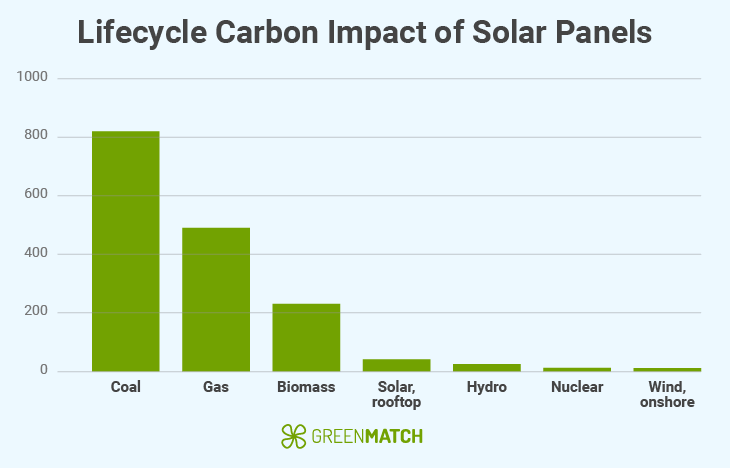
There are two main sources of solar panels:
- Solar photovoltaic (PV) panels, which are placed on rooftops, absorb the sun's light and convert it into electricity.
- Solar thermal systems use sunlight to heat water directly, which can be used for showers, washing and heating.
Many eco-friendly homes use a combination of the two to ensure maximum efficiency and sustainability. Homeowners can generate clean, renewable energy while reducing reliance on the grid. When integrated with good insulation, ventilation, and passive design strategies, solar energy contributes to a balanced and sustainable home that is both environmentally and financially beneficial. As a result of eco-design within homes and businesses, solar energy has produced 11% of the EU’s electricity, according to Euronews.
5. HVAC systems and heat pumps
Heating, ventilation and air conditioning are essential components in an eco-home. These elements aim to provide clean indoor air, regulate temperature, and reduce condensation while minimising the reliance on energy consumption.
Heat pumps are quickly becoming a key player in replacing traditional fossil fuel boilers. They work by extracting heat from either the air or the ground to heat and cool a home. They are highly efficient as they use electricity to move heat rather than generate it. According to MIT, heat pumps can reach up to 300% to 400% in efficiency, meaning they’re putting out three to four times as much energy in the form of heat as they’re using in electricity.
There are two main types of heat pumps used in eco-homes:
- Air-sourced heat pumps: Extract heat from the outside air.
- Ground-sourced heat pumps: Extracts heat from the ground.
In eco-homes, HVAC systems (Heating, Ventilation, and Air Conditioning), systems are designed to work efficiently in tandem with the building’s airtightness and insulation. The most sustainable setups often include:
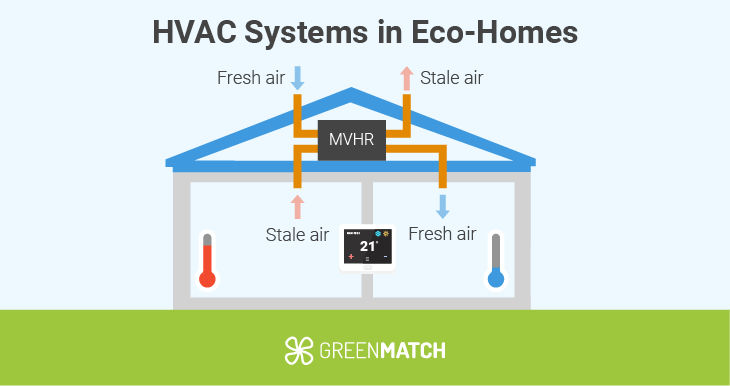
- Mechanical ventilation with heat recovery: This system removes stale air from the home and replaces it with fresh air while simultaneously recovering up to 95% of heat from the outgoing air.
- Zoned heating and cooling: Eco-homes often use zoned systems that allow homeowners to control the temperature in different areas, reducing energy waste.
- Smart thermostats and controls: Digital systems that help monitor and automate temperature, ventilation, and humidity, optimising efficiency throughout the year.
In a well-designed eco-house, HVAC systems and heat pumps work together with insulation, ventilation, and renewable energy sources to create a balanced and efficient heating and cooling system. The goal is to reduce the overall energy demand while maintaining a stable and comfortable indoor environment throughout the year.
6. High-performance windows and doors
High-performance windows and doors are essential for improving thermal comfort within any home. Poorly insulated windows and doors can account for 25% to 30% of heat loss. With eco-friendly houses, an emphasis on efficient windows and doors is paramount.
This involves the installation of double-glazed or triple-glazed windows, which provide airtightness within the home, enhancing thermal comfort while also helping with noise reduction. Additionally, doors throughout an eco-home, especially ones that are exposed to the exterior, can either be double or triple-glazed.
Eco-friendly design also puts emphasis on the placement of windows and doors throughout the home. For example, large windows are placed in south-facing walls to ensure maximum solar gain.
Benefits of eco-friendly house designs
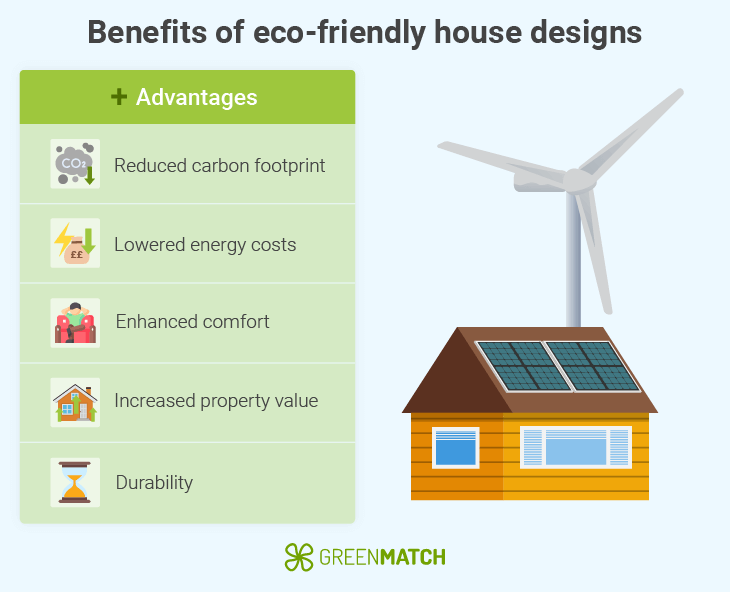
Eco-friendly house designs not only benefit the environment but also improve the lives of its occupants by lowering maintenance and electricity costs and improving overall comfort within the home. By integrating sustainable materials, better insulation, ventilation and renewable energy sources, eco-homes create healthier and more resilient living spaces.
- Reduced carbon footprint: Traditional homes account for 30% of energy used in the UK. By using renewable energy sources and opting for sustainable materials, sustainable homes reduce carbon emissions and lower the homeowner’s carbon footprint.
- Lowered energy costs: Eco-friendly homes use high-performance insulation, energy-efficient windows, and renewable energy sources like solar panels and heat pumps to reduce energy consumption. This lowers heating, cooling, and electricity costs, resulting in significant long-term savings.
- Enhanced comfort: Improved insulation and better air quality enhance the indoor comfort of a home. This not only saves energy but also leads to a healthier living environment, free from allergens, pollutants, and moisture-related issues.
- Increased property value: Sustainable homes are increasingly more in demand due to the high rising energy costs in the UK, as well as the desire to be more eco-conscious. As a result, eco-homes often have higher market value and faster resale potential.
- Durability: Sustainable materials like reclaimed wood, hempcrete, and bamboo are durable and require less maintenance over time. Smart home systems also help optimise performance and reduce wear and tear.
The future of sustainable house design
The future of sustainable house design is not just about reducing energy consumption or limiting environmental impact. It is about creating a home that is healthier, smarter and more in tune with the natural world. Concepts like biophilic design aim to blend the modern world with natural elements, resulting in homes that are not only sustainable but also support well-being.
The demand for eco-homes is growing. With this demand, governments are beginning to explore the concepts of eco-neighbourhoods and forest cities. These concepts aim to integrate greener homes on a national scale with the inclusion of vertical forests, community gardens, and rewilded spaces. These areas can support biodiversity and cleaner air.
However, one of the biggest challenges that face sustainable design is affordability. Ambitious projects like the Malaysian Forest City show how costly and exclusive these developments can be, often leaving them empty and inaccessible to the average person. For sustainable housing to have a real impact, it must be affordable and inclusive.
Fortunately, continued development and research are closing the gap. The use of low-impact materials like hempcrete and bamboo is helping sustainable homes to become more attainable. Additionally, the development of smart home technologies can help homeowners optimise their heating, lighting, ventilation, and energy use, making sustainable living more seamless and efficient.
Together, these trends point toward a future where homes are not only efficient but regenerative, designed to give more than they take for both people and the planet.
FAQ
An eco-friendly house is designed to minimise its environmental impact by reducing energy consumption, utilising sustainable materials, and promoting efficient use of renewable energy such as solar energy.
Eco-friendly houses reduce energy costs, enhances comfort, increases property value and lower the home’s overall carbon footprint.
Common sustainable materials include reclaimed wood, bamboo, hempcrete, sheep wool insulation, and recycled materials, which are durable, renewable, and environmentally friendly.
Yes, existing homes can be upgraded with better insulation, energy-efficient windows, renewable energy systems, and water-saving fixtures to improve sustainability.

Caoimhe is an experienced content writer and researcher who is passionate about providing accessible information to every reader. With a background in English literature and Sociology, she combines the two disciplines to create cohesive, well-thought-out, and well-informed pieces.
We strive to connect our customers with the right product and supplier. Would you like to be part of GreenMatch?

